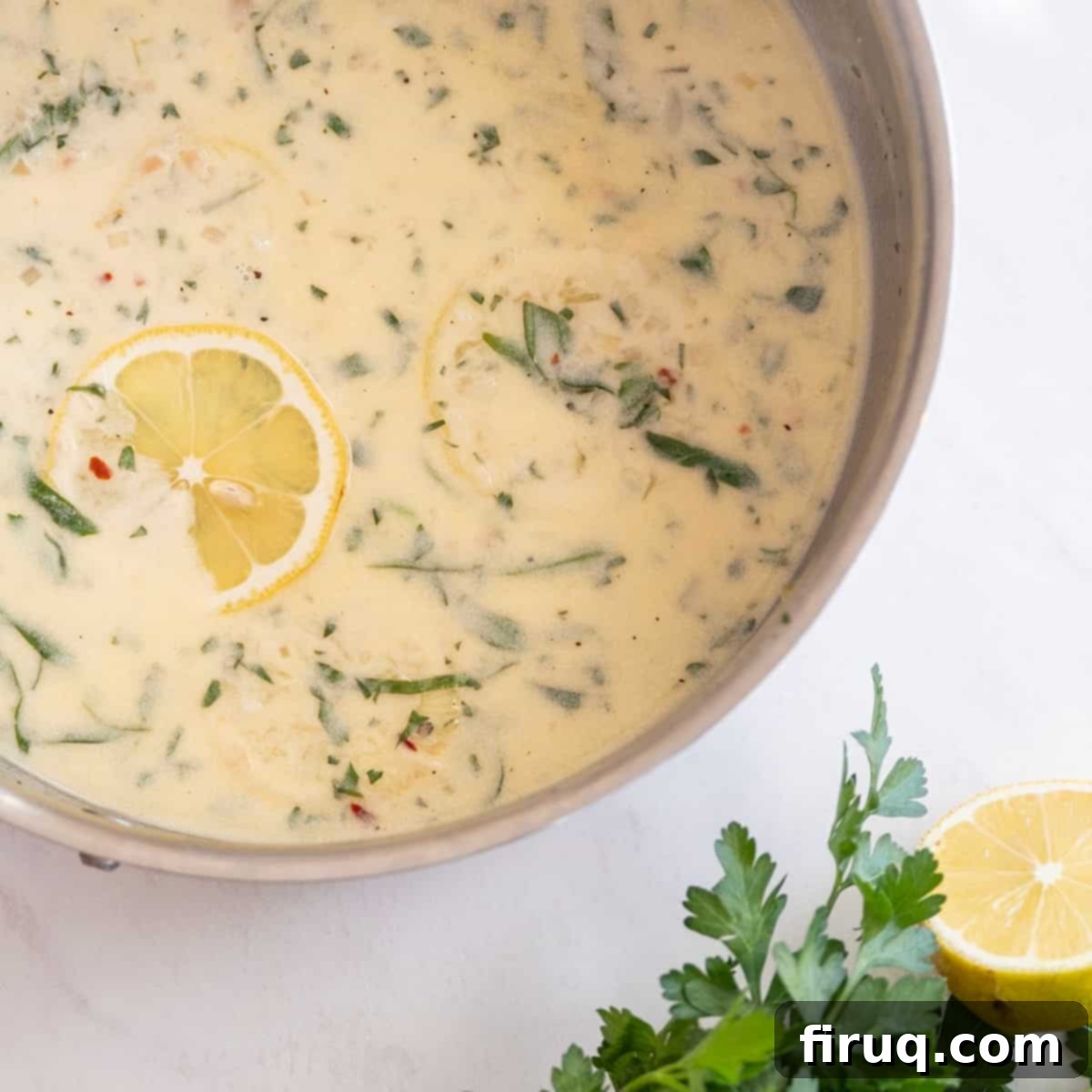The Ultimate Creamy Lemon Sauce: Elevate Every Meal with This Versatile & Easy Recipe
For those of us navigating busy schedules, finding fresh and exciting dinner ideas each night can be a challenge. That’s where a truly versatile recipe becomes a kitchen superhero. Our Creamy Lemon Sauce is precisely that – a vibrant, rich, and incredibly adaptable concoction that promises to transform ordinary ingredients into an extraordinary meal. Whether you’re planning on chicken breast, succulent shrimp, tender steak, or a medley of fresh vegetables, this sauce is your go-to for adding a burst of bright, tangy, and undeniably creamy flavor.
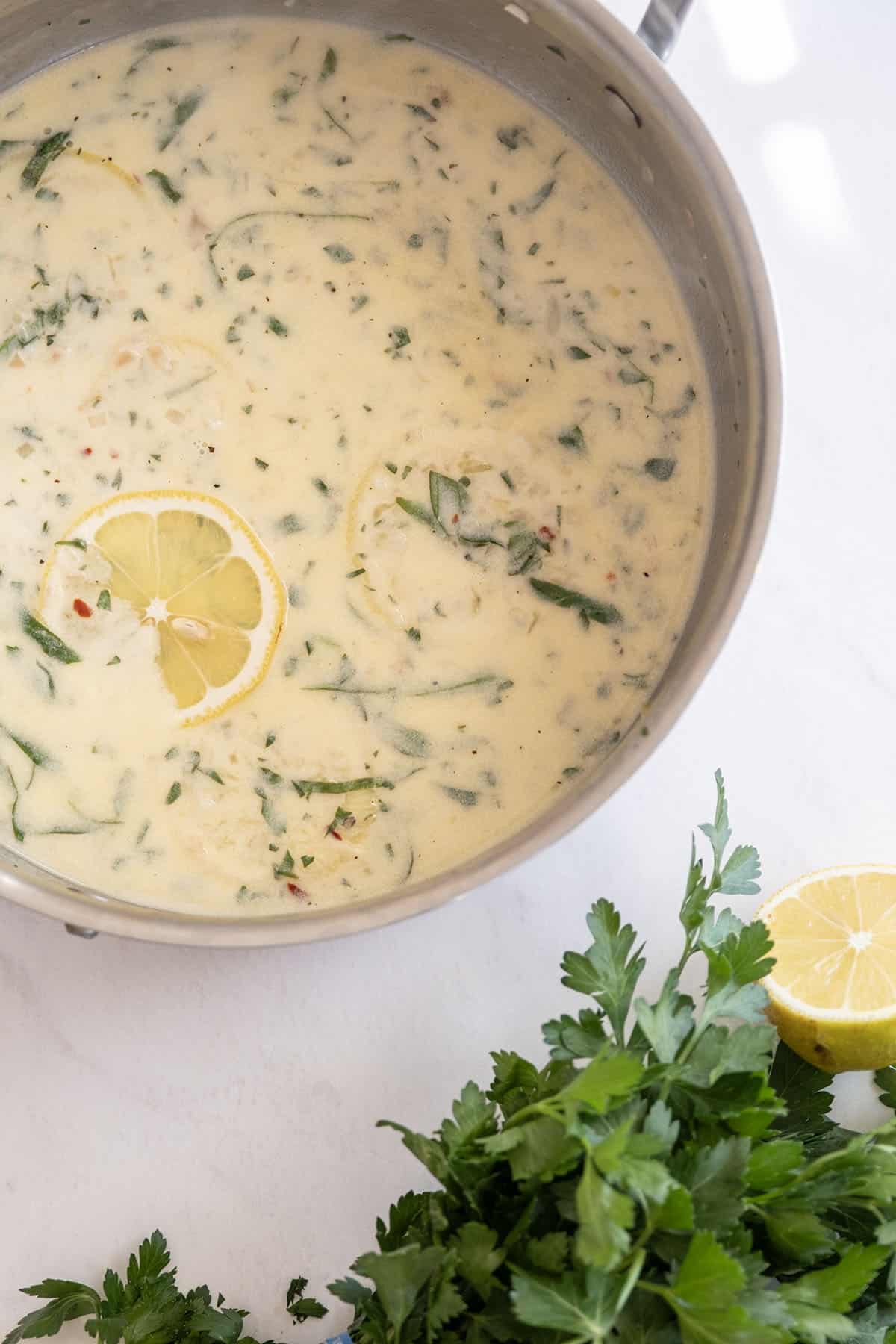
This incredible sauce is perfect to complement our Chicken Breast in Lemon Butter Sauce or to add a new dimension to our Crispy Italian Chicken Cutlets.
[feast_advanced_jump_to]
Why This Creamy Lemon Sauce Is Your New Weeknight Essential
In the whirlwind of daily life, it’s all too easy to fall into a culinary rut, preparing the same familiar meals week after week. We’ve all been there – a steady rotation of a few trusted recipes to get dinner on the table. While staples like chicken cutlets are always welcome, the desire for variety often leads to extra planning and effort, which busy individuals rarely have in abundance. This Creamy Lemon Sauce recipe is designed to break that cycle, offering an effortless way to introduce exciting new flavors without needing to invent an entirely new dish.
Imagine being able to prepare your preferred protein – be it chicken, shrimp, pork, steak, or even hearty chickpeas – and instantly transform it with a luxurious, zesty sauce that tastes far more complex than it is to make. This recipe empowers you to “switch it up” with minimal fuss, turning a simple pan-seared chicken breast into a gourmet experience or elevating a basic plate of pasta. It’s a fantastic accompaniment, for instance, served over a Classic Pork Chop Milanese, adding a bright counterpoint to its crispy texture.
Beyond its incredible versatility, this white wine-based sauce serves as a fantastic learning tool. The more you prepare it, the more intuitive you’ll become with the fundamentals of sauce-making. You’ll grasp the delicate balance of acidity, richness, and aromatics, gaining confidence in the kitchen and building a foundational skill that will serve you well in countless other recipes. Having this easy, flavorful, and adaptable sauce recipe in your repertoire is truly a game-changer for enjoyable and varied weeknight dinners.
Essential Ingredient Notes and Smart Substitutions for Your Creamy Lemon Sauce

- White Wine: The choice of white wine profoundly impacts the sauce’s depth. For a dry white, I consistently reach for a crisp Sauvignon Blanc or a light Pinot Grigio. The golden rule here is to use a wine you would genuinely enjoy drinking. If you prefer not to use alcohol, or don’t have a bottle on hand, a good quality chicken or vegetable broth can be an excellent substitute. While the flavor profile will differ slightly, it will still yield a delicious and savory sauce.
- Capers: Capers provide a delightful briny, salty pop that I personally adore. They introduce a unique tang that perfectly complements the lemon and cream. However, I understand that not everyone shares this love for capers! If you’re among those who despise them, rest assured, you can easily omit them without significantly affecting the structural integrity or overall deliciousness of the sauce. The lemon and other herbs will carry the flavor beautifully.
- Butter: This is a crucial element for achieving that luxurious, silky texture. Always, and I mean *always*, use cold butter. The reason behind this is scientific: cold butter melts slower, allowing its milk fats to gradually emulsify into the sauce. This slow integration helps to thicken and enrich the sauce without “breaking” it (where the fats separate), resulting in a consistently smooth and glossy finish. Both salted and unsalted butter can work; if using salted, simply adjust the added salt to taste.
- Heavy Cream: The heavy cream is what gives this sauce its signature creamy body. Ensure you’re using actual heavy cream (or whipping cream) with a fat content of at least 36% for the best results. Lighter creams or milk products might curdle due to the lemon’s acidity if not handled very carefully, and won’t provide the same richness.
- Lemon: Fresh lemon juice is non-negotiable for this recipe. Its bright, zesty acidity is the star. While you can use bottled lemon juice in a pinch, fresh lemons offer a far more vibrant and authentic flavor. Don’t forget to add a few thin lemon slices to simmer in the sauce; they infuse an aromatic depth without making the sauce overly sour.
- Shallots and Garlic: These aromatic vegetables form the flavor base of the sauce. Freshly minced shallots provide a delicate, sweet onion flavor, while fresh garlic adds a pungent warmth. Avoid pre-minced versions if possible, as their flavor is often diminished. If you don’t have shallots, a very finely minced small onion can be used, though the flavor will be slightly stronger.
- Fresh Herbs (Parsley & Basil): Fresh herbs are key to the sauce’s bright finish. Flat-leaf parsley offers a clean, peppery note, while fresh basil adds a hint of sweet anise. Always stir these in at the very end to preserve their vibrant color and fresh flavor. Dried herbs can be used in a pinch (use about a third of the amount), but fresh truly makes a difference here.
- Crushed Red Pepper: This adds a subtle warmth and a gentle kick, balancing the richness of the cream and the tartness of the lemon. Adjust the amount to your personal spice preference, or omit it entirely if you prefer a milder sauce.
*Please see more detailed notes about ingredients below in the recipe card for specific quantities.
Delicious Variations: How to Use Your Creamy Lemon Butter Sauce with Almost Anything
One of the most appealing aspects of this white wine lemon butter sauce is its incredible adaptability. It’s truly a foundational recipe that pairs harmoniously with a vast array of proteins and vegetables, making it a fantastic tool for meal prepping and adding diversity to your weekly menu. We frequently use it to create our popular Chicken Breast in Lemon Butter Sauce, a testament to its crowd-pleasing appeal.
Here are just a few ideas for how you can incorporate this exquisite creamy lemon sauce into your meals:
- Grilled or Roasted Asparagus: Drizzle generously over tender, crisp asparagus for an elevated side dish. The bright lemon cuts through the slight bitterness of the asparagus beautifully.
- Chicken Dishes: Beyond chicken breasts, this sauce is divine with chicken thighs, especially when seared to a golden crisp. It’s also an exceptional partner for crispy Italian Chicken Cutlets, offering a rich and zesty contrast. Try it served over Cast Iron Lemon Basil Orzo with Chicken Thighs for a complete, flavorful meal.
- Shrimp Scampi: Take your shrimp dishes to the next level. Serve this creamy lemon sauce with Shrimp Scampi with Zoodles for a lighter, yet incredibly satisfying, low-carb option. It also works wonderfully with pan-seared or grilled shrimp.
- Pork Chops: This sauce complements the richness of pork beautifully. Spoon it over pan-seared or grilled Cast Iron Boneless Pork Chops for a juicy and flavorful main course.
- Seared Flank Steak: While often associated with red wine sauces, the bright acidity of this lemon sauce offers a refreshing and unexpected twist to a perfectly seared flank steak.
- Cauliflower Steaks: For a fantastic vegetarian option, roast or pan-sear thick slices of cauliflower until tender-crisp, then smother them in this creamy lemon goodness. It turns a humble vegetable into a showstopper.
- Mussels: If you love seafood, you absolutely must try this. While our Steamed Mussels in White Wine is a classic, imagine using this creamy lemon sauce as the base for steaming your mussels. The mollusks will soak up every bit of that delicious, tangy flavor, creating an unforgettable dish perfect with crusty bread for dipping.
- Pasta Dishes: Toss freshly cooked pasta with a generous amount of this sauce for a quick and elegant meal. Add some sautéed spinach or cherry tomatoes for extra color and nutrition.
- Grains: Spoon it over fluffy couscous, quinoa, or rice to add flavor and moisture to your grain bowls.
The possibilities are truly endless, making this recipe a testament to the power of a perfectly crafted, versatile sauce.
Mastering Your Creamy Lemon Sauce: Step-by-Step Guidance
This recipe focuses solely on creating the luscious sauce itself. A brilliant aspect of this method is that you can cook your chosen protein or vegetable in the same pan *just before* you begin making the sauce. This allows the fond (those delicious browned bits) left in the pan to infuse even more flavor into your sauce, enhancing its depth and complexity.
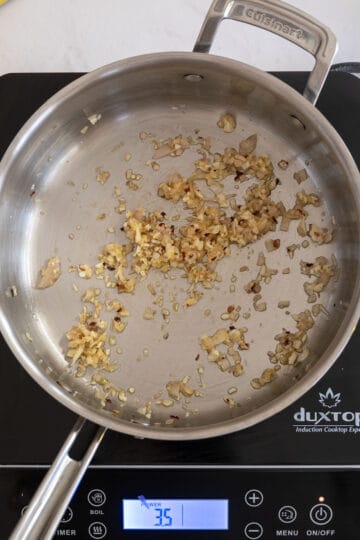
Step 1: Build the Flavor Base. Begin by adding olive oil to your pan (the same one you cooked your protein in, if applicable) over medium heat. Once shimmering, stir in the minced shallots and sauté gently for 3-4 minutes, or until they become translucent and softened, releasing their sweet aroma. Next, add the minced garlic and continue to sauté for another 1-2 minutes. Be careful not to burn the garlic, as it can turn bitter very quickly. Season lightly with salt at this stage to enhance the aromatics.
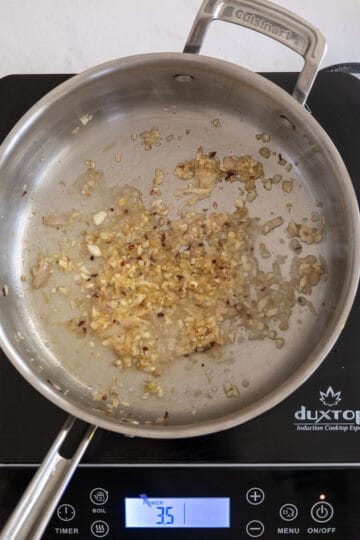
Step 2: Introduce the Brightness. Squeeze in the fresh juice from the lemon and stir to combine. The acidity will help deglaze the pan, lifting any flavorful bits from the bottom. Add the crushed red pepper for a subtle hint of warmth. Allow the lemon juice to gently simmer for just 15-30 seconds, stirring continuously. This brief simmer helps mellow the tartness slightly and infuse its flavor.
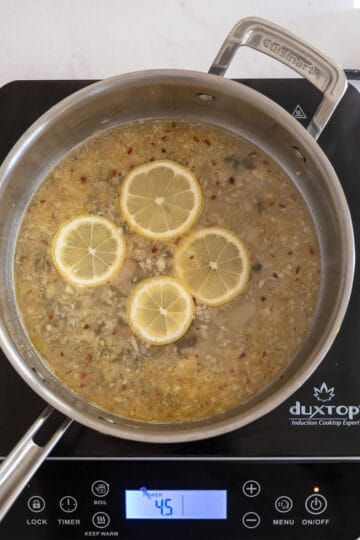
Step 3: Deglaze and Deepen. Pour in the white wine, adding a few lemon slices and the capers (if using). Increase the heat slightly and bring the wine to a gentle simmer. Allow it to simmer for 5 minutes. This step is crucial for “burning off” the alcohol and concentrating the flavors of the wine and lemon, creating a more complex and aromatic base for your creamy sauce.
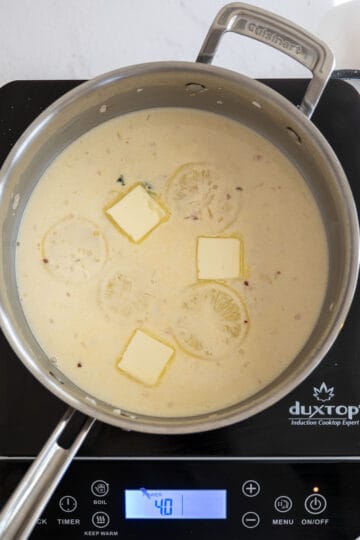
Step 4: Create the Creamy Velvety Texture. Reduce the heat to low. This is a critical step for preventing curdling. Slowly, pour in the heavy cream while continuously stirring with a whisk. Once the mixture is gently heated through and smoothly combined, begin adding the cold butter, one tablespoon at a time, whisking constantly until each piece is fully incorporated. The cold butter will slowly melt and emulsify, adding richness, body, and a beautiful sheen to your sauce.
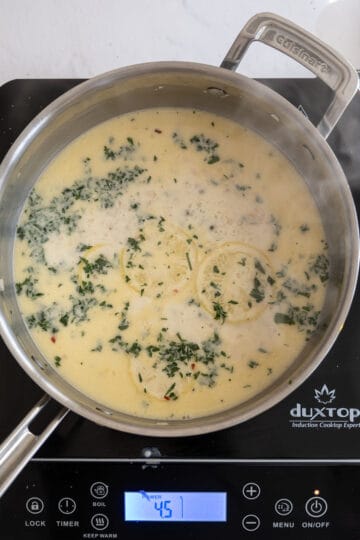
Step 5: Finish with Freshness. Stir in the chopped parsley, julienned basil, and black pepper. Allow the mixture to return to a very low, gentle bubbling simmer for 5-10 minutes. This final simmer allows the flavors to meld beautifully and the sauce to thicken slightly. Taste and adjust seasoning as needed – you might want a touch more salt or pepper depending on your preference.
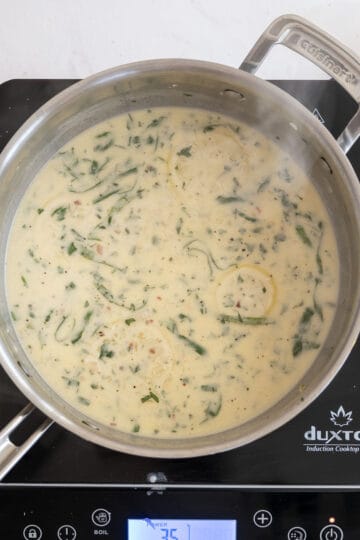
Step 6: Serve and Enjoy! Your creamy lemon sauce is now perfectly complete and ready to be united with your chosen main. Whether it’s fully cooked chicken, shrimp, tender cauliflower, or another fish or vegetable, gently add it directly into the simmering sauce. This final embrace allows the flavors to truly marry and ensures every bite is coated in this delightful creation.
I always recommend adding whatever protein or vegetable you’re serving directly into the sauce while it’s still simmering. If your chicken, for example, needs a bit more cooking time to reach an internal temperature of 165 degrees F, letting it finish in the sauce is ideal. This not only ensures it’s perfectly cooked but also allows it to absorb all the incredible flavors.
You might notice that the sauce appears a little watery immediately after cooking. Don’t fret! As it cools slightly, even for just 3-5 minutes, it will naturally thicken to that perfect, luscious consistency you desire. This natural thickening is part of the magic of a butter-emulsified sauce.
For those who adore lemon-flavored dishes, consider serving this versatile sauce alongside Lemon Pasta with Spinach for a double dose of citrusy goodness. Or, for a unique morning treat, indulge in the creamy, lemony delight of Lemon Ricotta Blueberry Pancakes.
Expert Pro-Tips for Perfect Creamy Lemon Sauce
- Temperature Control is Key for Cream: When it’s time to add the heavy cream, the absolute most important rule is to keep the heat very low. If your pan is too hot and the sauce boils vigorously after adding cream, it risks curdling. You might even consider briefly taking the pan off the heat for a minute before slowly pouring in the cream, especially if you find it hard to maintain a very low simmer on your stovetop. Whisk continuously and steadily as you pour the cream to ensure it integrates smoothly and emulsifies properly. The goal is a gentle, almost imperceptible simmer, not a rolling boil.
- Embrace its Versatility: This creamy lemon sauce is a true chameleon in the kitchen. It’s not just a single-use condiment but a foundational recipe that can fundamentally change your approach to weeknight meals. Learning this one sauce opens up a world of possibilities for mixing and matching proteins and vegetables. We regularly enjoy it with plump shrimp, tender chicken, flavorful steak, and even robust cauliflower steaks. Don’t be afraid to experiment and discover your own favorite pairings!
- Storage and Reheating: If you have any leftover sauce, store it in an airtight container in the refrigerator for up to 3-4 days. When reheating, do so gently over low heat on the stovetop, stirring frequently. If it appears a little too thick, you can whisk in a tablespoon or two of warm broth or water to bring it back to the desired consistency. Avoid high heat or vigorous boiling when reheating to maintain its creamy texture.
- Don’t Rush the Butter: The butter addition is an art. Adding cold butter slowly and whisking it in ensures a stable emulsion, resulting in that glossy, restaurant-quality finish. Resist the urge to dump it all in at once, as this can cause the sauce to separate or become greasy.
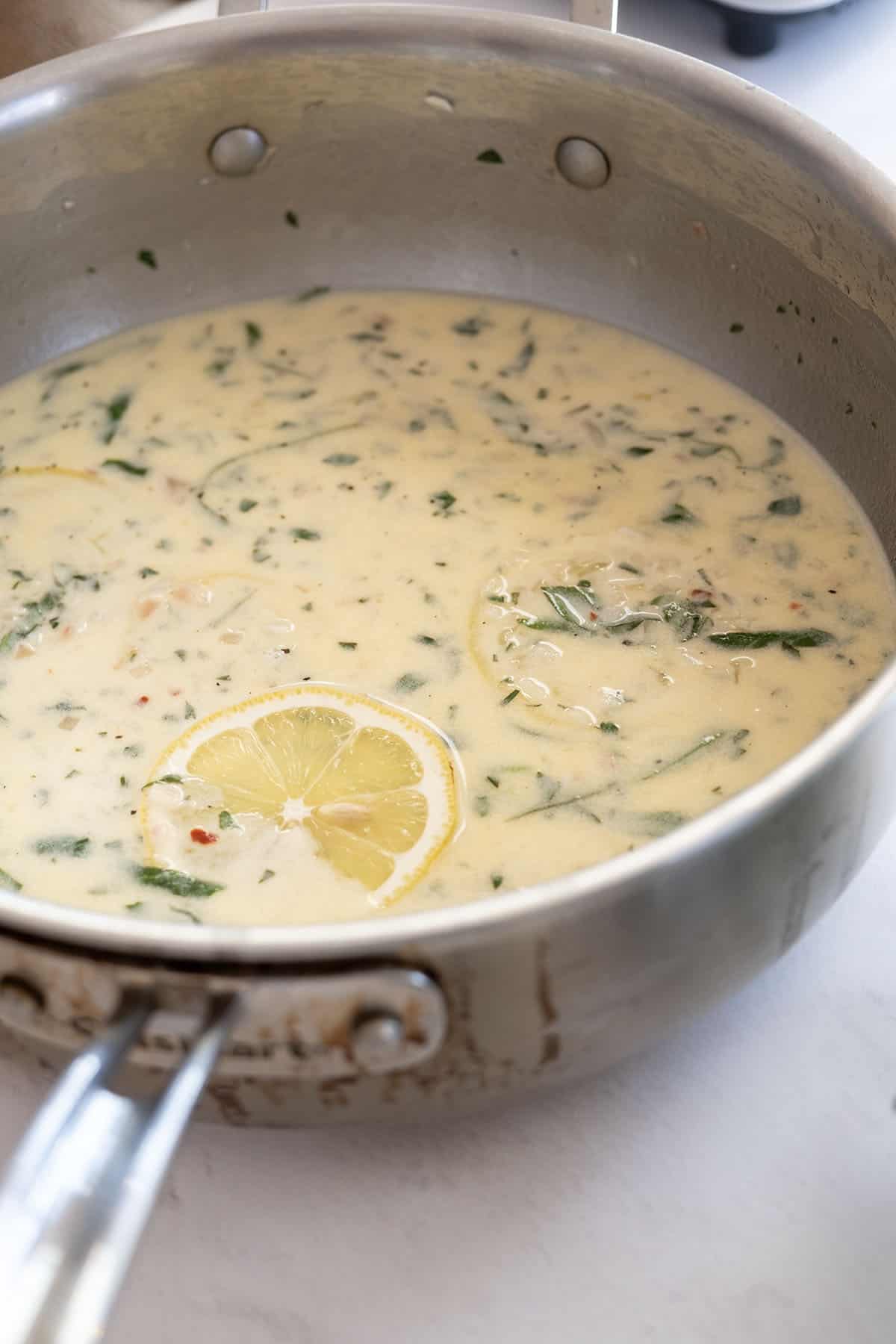
Creamy Lemon Sauce: Your Questions Answered
Using cold butter is a classic chef’s trick for making incredibly smooth and rich sauces. Cold butter dissolves much slower than room temperature butter, allowing its milk fats to gradually separate and integrate into the sauce. This slow process, especially when whisked continuously, creates a stable emulsion, helping to thicken the sauce and give it a beautiful, glossy finish without breaking (or separating) into an oily mess. Room temperature butter, by contrast, would melt too quickly, making it more likely for the sauce to break and become greasy.
The key to successfully adding heavy cream to an acidic base like lemon juice or wine without it curdling lies in controlling the temperature and the speed of addition. Always reduce the heat to low before pouring in the cream. Pour it very slowly and continuously whisk the sauce as you do so. This gentle, steady incorporation allows the cream to gradually warm up and evenly distribute its fat content throughout the acidic liquid, preventing the milk proteins from clumping together and curdling. Never let the sauce come to a boil once the cream has been added.
While this creamy lemon sauce will naturally thicken as it cools slightly, if you find it still too thin for your liking, there are a couple of methods. The simplest approach, and my personal recommendation for this recipe, is patience: just let it cool for 3-5 minutes off the heat, and you’ll notice a significant increase in thickness. If you absolutely need it thicker right away, you could create a cornstarch slurry (1 tablespoon cornstarch mixed with 1 tablespoon cold water) and whisk it into the simmering sauce. Be mindful that using a slurry, especially cornstarch, can give leftovers a slightly gelatinous texture. A flour slurry (roux) isn’t typically recommended for this type of delicate, emulsified sauce as it can dull the flavors and texture.
While the traditional recipe relies on dairy butter and heavy cream for its signature richness, you can adapt it to be dairy-free. Substitute the butter with a high-quality, plant-based butter alternative (ensure it’s suitable for cooking). For the heavy cream, use a full-fat canned coconut cream (the thick part from the top of a can of coconut milk, chilled) or a dairy-free heavy cream alternative. Be aware that coconut cream will impart a subtle coconut flavor, which may or may not be desirable depending on your dish. Always follow the same low-heat, slow-whisking technique when adding dairy-free cream to prevent separation.
If your sauce appears to have broken (looks oily and separated), don’t panic! This usually happens if the heat was too high when adding the cream or if the butter was added too quickly. You can often rescue it. Take the pan off the heat and vigorously whisk in 1-2 tablespoons of cold water or cold broth, a teaspoon at a time. The cold liquid can help to re-emulsify the fats and bring the sauce back together. Alternatively, in a separate bowl, whisk an egg yolk with a tablespoon of cold water, then slowly drizzle a small amount of the broken sauce into the egg yolk mixture while whisking. Then, pour the tempered egg yolk mixture back into the main pan of sauce, whisking constantly over very low heat until it comes back together. Avoid boiling.
Delectable Recipes to Pair with Your Creamy Lemon Butter Sauce
- Fried Flounder OreganataA light, crispy fried flounder dish that will sing when paired with the bright, creamy lemon sauce.
- Chicken Breast in Lemon Butter SauceThis is the quintessential pairing, demonstrating just how perfectly this sauce complements tender chicken breast.
- PERFECT Cast Iron Chicken BreastA flawlessly cooked chicken breast becomes an incredible canvas for this creamy, zesty sauce.
- Cast Iron Lemon Dill SalmonEnhance the natural flavors of this delightful salmon with an extra layer of creamy lemon.
Please leave a comment and star rating below in the recipe card! I love to hear what you think of our recipes and how you make them your own. Feel free to tag us on Instagram @vindelgiudice so we can see your amazing creations.
📖 Recipe
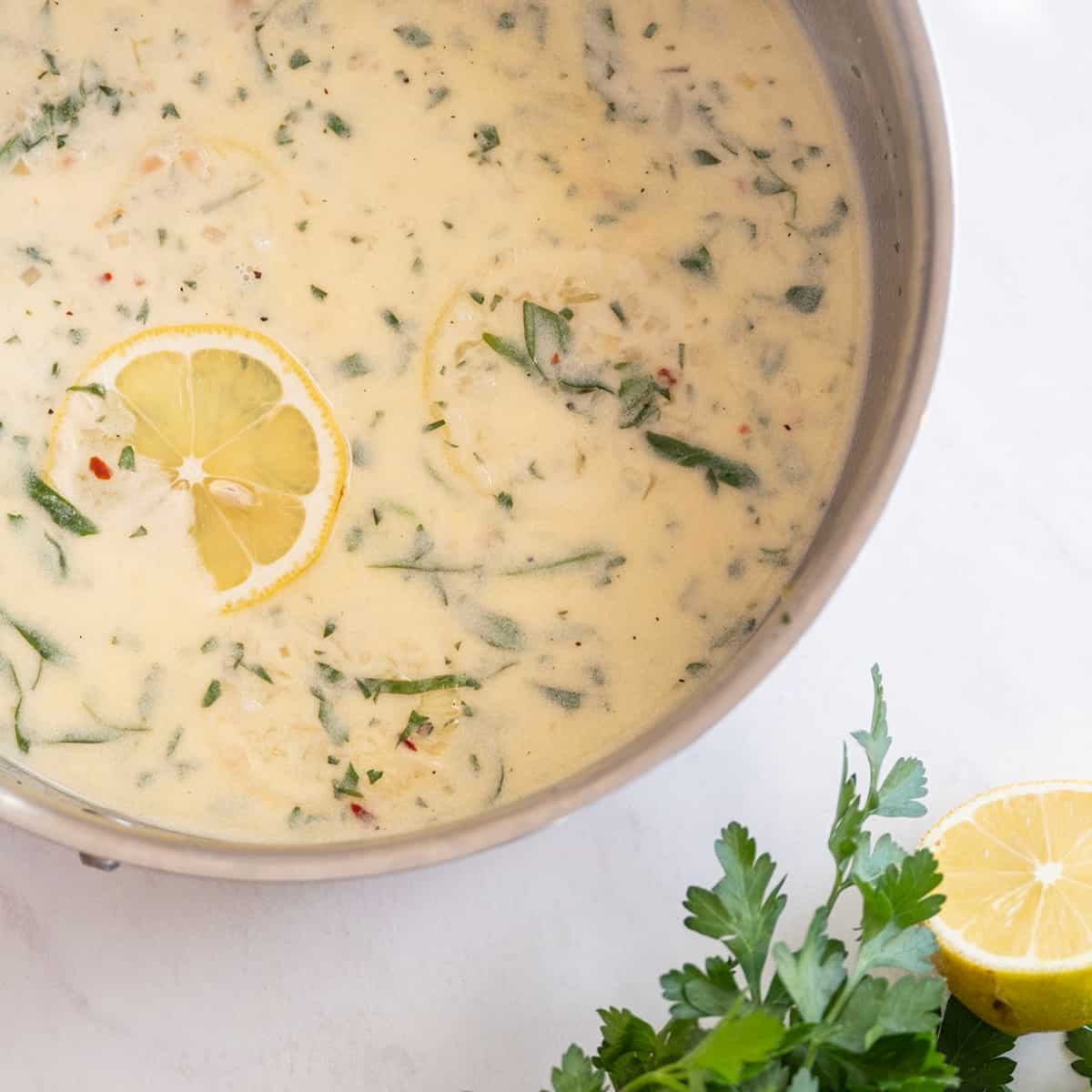
Creamy Lemon Sauce
Vincent DelGiudice
Pin Recipe
15 minutes
15 minutes
30 minutes
Main Course
American, Italian
8
servings
133
kcal
Equipment
-
1 large saucepan
Ingredients
-
2
tablespoon
olive oil -
2
cloves
garlic minced -
1
shallot, minced -
1
lemon -
½
teaspoon
crushed red pepper -
1
cup
white wine -
1
tablespoon
capers -
½
cup
heavy cream -
3
tablespoon
butter -
2
tablespoon
chopped parsley -
2
tablespoon
basil, julliened -
½
teaspoon
kosher salt -
¼
teaspoon
black pepper
Instructions
-
Add olive oil to the pan over medium heat. Stir in the shallots and saute for 3-4 minutes or until softened. Add in the garlic and saute for another 1-2 minutes. Season with salt.
-
Squeeze in the juice from the lemon and combine. Add the crushed red pepper. Once the lemon is simmering about 15-30 seconds, pour in the wine. Bring the wine to a simmer for 5 minutes. Add in some slices of lemon and the capers.
-
Reduce the heat and slowly add the heavy cream while stirring. Add in the butter once the mixture is heated through and combine. Stir in the parsley, basil, and black pepper. Let the mixture come to a low bubbling simmer for 5-10 minutes or until thickened.
-
The sauce is complete and you can add whatever you want into the sauce now whether it be chicken, shrimp, cauliflower, or another fish or vegetable.
Notes
- Keep the heat low when you add the heavy cream. Don’t let it come to a boil. A very low simmer is perfect.
- This sauce is great for all kinds of proteins and vegetables. It’s a great base recipe to learn so that you can mix it up with different meals for your family.
Nutrition
Calories:
133
kcal
Carbohydrates:
3
g
Protein:
1
g
Fat:
13
g
Saturated Fat:
7
g
Polyunsaturated Fat:
1
g
Monounsaturated Fat:
5
g
Trans Fat:
0.2
g
Cholesterol:
28
mg
Sodium:
289
mg
Potassium:
69
mg
Fiber:
1
g
Sugar:
1
g
Vitamin A:
502
IU
Vitamin C:
9
mg
Calcium:
22
mg
Iron:
0.4
mg
Tried this recipe?
We’d love for you to Leave a Review!
